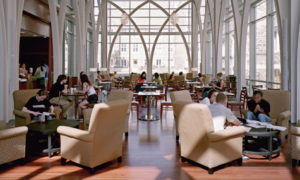The sound ecology in a workplace that can be used to measure and improve productivity is similar to the sound ecology in a study space where in both cases, individuals have certain goals that need to be accomplished. For students in study spaces, goals range from reading an article, deriving a formula, preparing for an interview, writing an essay, filling out a form etc. Each individual has a preference of which kind of sound environment is most conducive to their learning style and study preferences. It may not be so simple as noise or no noise.
Personally, I prefer to fill out forms, answer emails, and read articles in louder spaces. This atmosphere is commonly found in coffeeshops like Vondy on Duke’s campus in Perkins Library. The architecture in Vondy is integrated into the sound ecology of the space by way of the desired atmosphere. The high ceilings, open feeling, and uncarpeted floors do not have sound dampening qualities and noise regulation cues as seen on the inside of Perkins library. The space is not designed to be quiet.
I appreciate complete silence when I am trying to read a textbook or write an essay. While some are able to accomplish these things in a sound environment filled with white noise, chatter, and other distinct sounds that they are able to tune out, I find it hard to ignore the sounds and get distracted.
When working on problem sets or tasks without many words, I enjoy listening to music while I work. The sound and lyrics I am listening to do not interfere with the “sound” of numbers in my head. From my experiences, different types of music create different moods in which to study.
Combinations of sounds and studying offer different atmospheres which cater to different individual preferences in study environments for specific types of tasks or assignments. Hence, it is a universities responsibility to its students to provide a wide range of study spaces that vary in their characteristic, including their sound ecology.


